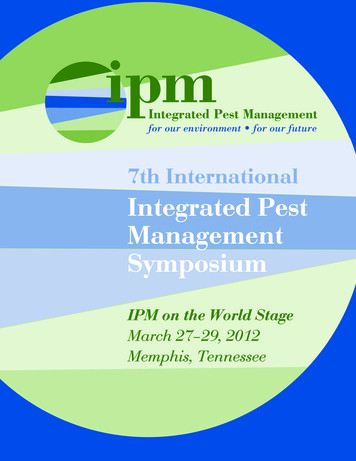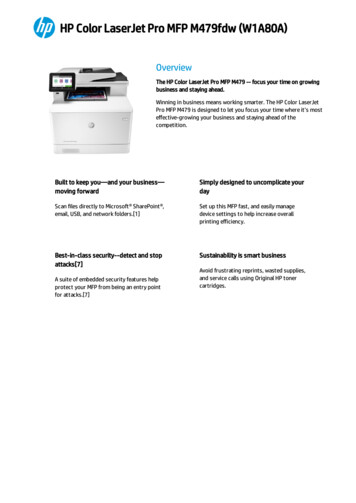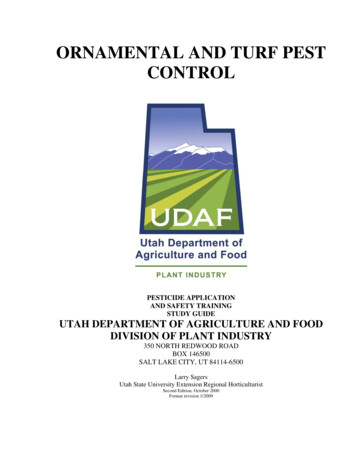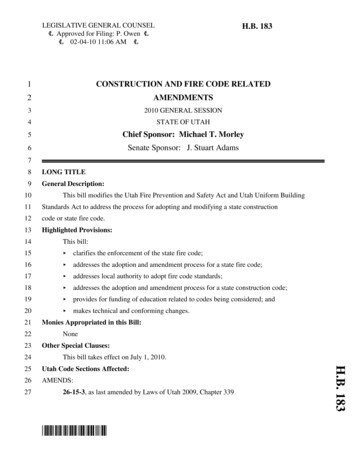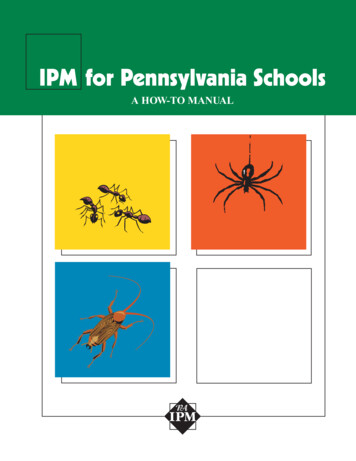
Transcription
IPM for Pennsylvania SchoolsA How-to Manual
IPM for Pennsylvania SchoolsA How-to ManualProduced by the Pennsylvania Integrated Pest Management ProgramCollege ofAgricultural SciencesCooperative ExtensionPennsylvania Department of AgricultureThe PA IPM Programis a collaboration between thePennsylvania Department of Agriculture andThe Pennsylvania State Universityaimed at promotingIntegrated Pest Managementin both agricultural and nonagricultural settings.As part of the PA IPM Program,the Pennsylvania Department of Agriculture,the Pennsylvania Department of Education,the Pennsylvania Department of Health, andThe Pennsylvania State UniversityColleges of Agricultural Sciences and Educationsigned a memorandum of understanding to promoteIPM implementation in schools.PA IPM drew on this partnership to developthis manual.Pennsylvania Department of Education
IPM for Pennsylvania SchoolsIntroduction to the 2007 EditionIn the six years since this manual was first published,legislation has been enacted requiring each Pennsylvaniaschool district, intermediate unit, and area vocationaltechnical school to develop an integrated pest management (IPM) plan (Act 35 of 2002) and to notify parentsand guardians 72 hours prior to any pesticide applicationsand post warning signs 72 hours prior to and 48 hoursafter any pesticide applications in school buildings or onschool grounds (Act 36 of 2002).In addition, the Pennsylvania Department of Healthrecommends that IPM be a part of indoor air quality (IAQ)guidelines for Pennsylvania schools. EPA studies of humanexposure to air pollutants indicate that indoor levels of pollutants may be two to five times higher than outdoor levels.Children, especially, may be susceptible to air pollution sincethey breathe a greater volume of air relative to their bodyweight than adults. One specific contaminant addressed bythe EPA’s report Indoor Air Quality Tools for Schools arepesticides. Chronic exposure to some pesticides can result indamage to the liver, kidneys, and nervous system.The following are some of the important changes tothis edition: A new section on “Who Does What?” that explains whatthe legislation requires of the school and others. The addition of “How to Develop an IPM Policy andPlan for Your School District” on page 13 shows theparts of an acceptable plan with an outline to adapt itfor your school. The Pennsylvania School Boards Association policyhas been replaced with an updated version reflecting theeffects of the school IPM legislation. A sample notification letter for parents and guardianshas been added, as well as a sample pest controlinformation sheet used to inform staff and parents andguardians about pesticide applications. The “Intent to Apply Pesticides” page has been replacedwith a “Notice of Pesticide Application” sign that is 8½inches by 11 inches as required by the legislation. The “Contract Guide Specifications,” pages 17–21, havebeen somewhat simplified. A “Frequently Asked Questions” section has beenadded on page 121 that answers many of the questionsPA IPM has received about proper application of IPMprocedures and interpretations of state pesticide laws. A description of the Worker Protection Standard is nowincluded in the “Supplemental Materials” section onpage 138. There is now a universal poison control number usednationwide: 1-800-222-1222. Copies of the acts are included in this edition on pages134–37. Additional resources have been listed and Web siteaddresses have been updated.In 2005, the Pennsylvania IPM Program (PA IPM)sent surveys to all 501 school districts in the state inquiring about the status of IPM implementation in schools.Of the 231 responses, 96 percent claim to use IPM tocontrol pests and have an IPM coordinator in place.Another 92 percent responded that they have an IPMpolicy, and 97 percent of respondents maintain recordson pest management activities. In addition, 94 percent ofschool districts surveyed used this manual to help developtheir IPM plans. Of the school districts that contract witha private pest control company, about 90 percent of themensured that IPM is part of the contract. Additionally, thesurvey indicated that ants, bees/wasps, and mice were themajor indoor pests that occur in schools. The most common outdoor pests included ants and weeds in landscapesand sidewalks.We hope this manual will encourage all schools inPennsylvania to develop their own IPM programs andtrain their personnel to become familiar with IPM practices. Some personnel may with to be trained as certified pesticide applicators. This recent edition reflects thechanges in Pennsylvania legislation, and it is hoped themanual will enable schools to enhance their IPM programs. Remember, IPM is not another thing to do, butanother way to do things. IPM in itself is not a goal to bereached, but a way to achieve a goal—safer, more effectivepest management.Recommendations given in this manual are current asof April 2007. For further information concerning IPM, visitthe PA IPM Web site at www.paipm.org.
IPM for Pennsylvania SchoolsAcknowledgmentsMany individuals and organizations have been involvedwith the development and production of this manual. Wethank the following reviewers, who provided invaluablesuggestions and corrections for the text:Project CoordinatorJ. Kenneth Long Jr., Former PA IPM Program Assistant,Penn StateThe Pennsylvania Department of AgricultureRoger Dressler, Plant Industry Region II SupervisorDave Scott, Pesticide Certification and Training, Healthand Safety DivisionJim Stimmel, Entomologist, Plant Protection DivisionJohn Tacelosky, Chief, Health and Safety DivisionDr. Karl Valley, Chief, Plant Protection DivisionThe Pennsylvania Department of EducationL. Jack Reynolds, Educational CoordinatorDr. Patricia Vathis, Director, Office of Environment andEcologyThe Pennsylvania Department of HealthJon W. Dale, Director, Division of School Health, Bureauof Community Health SystemsDennis Wilson, Environmental Health Administrator,Bureau of Community Health SystemsThe Pennsylvania State UniversityDr. Paul Heller, Professor of EntomologySteve Jacobs, Senior Extension Associate in UrbanEntomologyDr. Peter Landschoot, Associate Professor of TurfgrassScienceKerry Richards, Manager, Pest Management InformationCenter, Penn State Pesticide Education ProgramLyn Garling, Manager of Programs, Penn State, PA IPMProgramThe Pennsylvania Association of School Business OfficialsPatricia A. Haley, Industrial Hygienist, PASBO FacilitiesManagers CommitteeThe Pennsylvania Pest Management AssociationFred Goldberg, B.C.E., General Manager, PestManagement Associates; Pesticide Advisory Board,PPMAWin Higgins, Regional Entomologist, Western PestServices; IPM Chairman, PPMA Dana Lown, President, Ajax Pest Control; President,PPMAMichael Powers, President, Powers Pest Management,;President-Elect, PPMAJerry Siegfried, Training Director, J. C. Ehrlich Co, Inc.;PPMAOther ReviewersScott Camazine, M.D., Ph.D., Altoona Hospital,Altoona, Pa.Jack Getkin, Herrmann Associates, Pittsburgh, Pa.;Retired Registered School Business OfficialDr. Glenn Holbrook, EntomologistEd Van Istendal, Technical Director, B. & D. A.Weisburger, Inc.We also wish to acknowledge information provided by theUniversity of Florida School IPM Web site (Thomas R.Fasulo, Webmaster, University of Florida), United StatesEnvironmental Protection Agency, and other personnel in the Pennsylvania Department of Agriculture, thePennsylvania Department of Education, the Pennsylvania Department of Health, and The Pennsylvania StateUniversity.PA IPM Program StaffCathy Thomas, PA IPM Coordinator, PennsylvaniaDepartment of AgricultureDr. Ed Rajotte, Professor of Entomology and PA IPMCoordinator, Penn StateLyn Garling, Manager of Programs, Penn StateKristie Auman-Bauer, Public Relations and OutreachCoordinator, Penn StateMichelle Niedermeier, Community IPM CoordinatorSarah Pickel, Education Specialist, Penn StateAmber Gray, Curriculum Development Assistant, PennStateRhonda Griffin, Home Health Educator, Penn StateCathy Nardozzo, Webmaster, Penn StateDion Lerman, Environmental Health Program Specialist,Penn StateDesignerBarbara First, College of Agricultural Sciences,Penn StateEditorAmanda Rudisill, College of Agricultural Sciences,Penn State
IPM for Pennsylvania Schools ContentsIPM for Flies and Mosquitoes in Schools.59Introduction to the 2007 Edition.2IPM for Head Lice in Schools.72Getting Started with School IPM.5IPM for Rodents in Schools.74School Integrated Pest Management Informationfor the School Administrator.8IPM for School Lawns.77IPM for Silverfish, Firebrats, andBooklice in Schools.85IPM for Spiders and Ticks in Schools.87IPM for Trees and Shrubs onSchool Grounds.94IPM for Weeds on School Grounds.97IPM for Wood-Damaging Pests in Schools.101Inspection Checklist for DetectingStructural Decay and Pest Damage.111IPM for Yellowjackets and Hornetsin Schools.116A Model Integrated Pest ManagementPolicy for Schools.9School IPM Legislation.10How to Develop an Integrated PestManagement (IPM) Policy and Planfor Your School District.13Sample IPM Plan.15Contract Guide Specification or Request forProposal (RFP) for Integrated Pest ManagementPrograms in Pennsylvania Schools . .17Forms.22Technical Information forPennsylvania Schools—Pests .30Pests Found In and Around Schools.30IPM for Ants in Schools.33IPM for Clothes Moths andCarpet Beetles in Schools.38IPM for Cockroaches in Schools.43IPM for Fleas in Schools.54Frequently Asked Questions Concerning IPM Plansand Pesticide Notification Legislation, Acts 2002-35and 2002-36 of Pennsylvania .121Literature Citations and Additional References andResources for School Integrated Pest Management . .128Supplemental Materials to Help DevelopIPM Programs in Pennsylvania Schools.132Universal Poison Control Number1-800-222-1222.Inside Back Cover
IPM for Pennsylvania Schools Getting Started with School IPMSince April 2002, Pennsylvania has enacted legislationmandating the adoption of an Integrated Pest Management (IPM) plan for each school district, intermediateunit, and area vocational-technical school in the state,and a 72-hour notification and posting period prior topesticide use in schools or on school grounds.IPM is a decision-making process that emphasizespractices which quite often lead to a decrease in theamount of pesticide used. It manages pests throughsanitation, exclusion, and nonchemical devices ratherthan depending exclusively on pesticides. IPM usesinformation about pests’ life cycles to manage them withthe least impact on people and the environment.Pests are any living organisms that negatively affecthumans or their property. Pests include weeds and plantdiseases, as well as insects that feed on plants or storedproducts, transmit pathogens, or are nuisances. Other animals, such as snails, ticks, mites, mice, rats, groundhogs,pigeons, and deer, can become pests in certain situations.IPM Begins with PreventionAn essential element of IPM is to identify the root causeof pest problems at a particular site. Understanding whatpests need in order to survive is the key. Pests live in areasthat provide basic needs such as food, water, and shelter,so they often can be managed by removing one or moreof these necessities, such as food and water sources, or byclosing off entry points into buildings.Proper design of new construction and prompt repairsand building maintenance are essential.Another essential element of IPM is monitoring on anongoing basis to determine pest severity.The judicious use of pesticides is a part of an IPMprogram when monitoring indicates they are needed andnecessary.A fourth essential element of IPM is the involvementof the entire school community. In addition, some staffshould be trained in IPM implementation procedures.Whether an IPM program raises or lowers costsepends on housekeeping, maintenance, and pest management policies. The costs of setting up an IPM programalso can depend on whether pest management services arecontracted out or provided by in-house staff. Pennsylvanialaw allows pesticide applications in schools only by certified applicators, registered technicians, or by non-certifiedapplicators or non-registered technicians under the directsupervision of a certified applicator. Notification must begiven to all staff and parents or guardians of students whorequest it 72 hours prior to pesticide use. Warning signsmust also be posted in the vicinity 72 hours prior to andfor 48 hours after the application. The law also mandatesa 7-hour reentry period for common access areas wheneverpesticides are applied.Typically, implementing an IPM program may costmore at first because prevention and facilities maintenancemay need to be instituted. However, after the preventionactivities have been completed, IPM costs should be lowered due to reduced access by pests. New building designshould take pest management factors into consideration.Schools should follow these steps in starting an IPMprogram:1. Develop an IPM Policy StatementThe policy statement should explain what is expected,how existing services will be included, and howstudents and staff can take part in the program.A model policy statement (Policy 716 – IntegratedPest Management in Schools) developed by thePennsylvania Integrated Pest Management (PA IPM)Program and the Pennsylvania School Boards Association is found on pages 11 and 12.2. Set Pest Management ObjectivesExamples of pest management objectives include: designing new facilities and structures to preventpest occurrence and damage managing pests that may interfere with learning ina facility eliminating the possibility of injury to students andstaff preserving the integrity of buildings maintaining sports fields responding to children’s health issues and preventingthe spread of disease communicating about the IPM program withadministrators, teachers, parents, students, andmaintenance personnelAdapted for Pennsylvania schools from the University of Florida School IPM Web site article Getting Started with School IPM atschoolipm.ifas.ufl.edu/doc/started.htm.
IPM for Pennsylvania Schools3. Designate Pest Management RolesDesignating roles for the pest management professionals (PMP), staff, students, and parents is an importantpart of an IPM program. Cooperation is critical. Themore students and staff join in, the better an IPMprogram will work. IPM Coordinator. Each district should designate oneindividual as the district coordinator for the IPMprogram. In districts with more than one building,each building should designate a person to interactwith the district IPM coordinator. IPM Advisory Committee. Some schools have foundit helpful to establish an advisory committee tofacilitate communication. It could include parents,teachers, kitchen and maintenance personnel, andother interested persons. Students and Staff. The most important job forstudents and staff is to help in keeping the schoolclean. Preventing pests depends on everyone workingtogether to clean up litter and leftover food. Parents. Parents’ first school pest managementresponsibility is to learn about and follow IPM practices at home. Pests carried from home in notebooks,lunchboxes, or clothing can slow the success of anIPM program. Pest Manager or Contractor. The pest manager(in-house personnel certified as a pesticide applicatorin Category 23 of [7 PA. Code §128.42]) or contractor (certified pesticide applicator hired from outsidethe system) is the person who inspects the facility,monitors for pests, and decides if prevention or suppression measures are necessary. The pest manageralso keeps records of any pesticide use, includingthe kind and EPA Registration number, amount,location, and dates of application.4. Set Action ThresholdsThe mere presence of a pest does not always requirethe application of a pesticide. The pest manager andschool staff should decide in advance how many pestsare harmless and how many require management(in other words, how many can be tolerated). This iscalled the “action threshold” for management of aparticular pest. 5. Inspect Sites and Monitor for PestsInspecting sites for pests or pest-promoting situationsis an important part of IPM. The pest manager shouldidentify any pests found and attempt to determinewhere they came from. Structural and maintenancechanges to the building may then be used to reducepest numbers.Monitoring traps are placed in areas where pestshave been reported. The numbers of pests caught arecounted to determine if action thresholds (the amountof pests that can be tolerated) have been reached andsuppression measures are necessary.6. Apply IPM Management StrategiesWhen the number of pests exceeds the preset actionthreshold, the pest manager takes action. The pestmanager may physically remove the pests or suggesthabitat modifications that would prevent pests fromfinding food, shelter, and water. Other managementstrategies used in an IPM program may includebuilding repair, improved sanitation, or a targetedapplication of an appropriate pesticide.7. Evaluate Results and Keep RecordsAccurate record keeping allows the pest manager toevaluate the success of the IPM program. Records alsohelp in forecasting when a seasonal pest may appear orwhen an outbreak may occur.After a period of time, people involved with theprogram will gain a sense of IPM activity priorities.For example, any garbage or trash that may attractpests in and around the building must be removeddaily.
IPM for Pennsylvania SchoolsIPM Record Keeping ActivitiesKeep pest sighting logs in each room and check them ona weekly basis. Depending on circumstances, sticky trapsor glue boards used for monitoring cockroaches or miceshould be checked as needed.Regular (monthly) flashlight inspections of kitchen areas,behind appliances, sinks, soda machines, storage facilities, and other areas may be needed to locate cockroaches,silverfish, and ants. The cafeteria inspection check list onpages 28 and 29 can be used for these inspections.Depending on individual school situations, an annualinspection of athletic fields, turf, and ornamental plantsmay be sufficient. If records have been kept showing pastpest problems, the inspection may be adjusted to monthlyor weekly as needed. Seasonal inspections may be helpful in preventing someproblems. In the fall, at the beginning of the school year,many outside pests begin to migrate indoors. Be alert toprevent their entry into buildings. In spring, birds may attempt to nest in building corners or openings, increasingthe possibility of parasitic bird mites entering buildings.Needed structural repairs should be made as soon asfeasible to minimize pest entry. Check for gaps arounddoors, pipes, and wires in walls, torn screens, cracks inwalls, and other flaws that could give pests access.Consider creating a student “Pest Patrol” club tomonitor various areas of the building and grounds forpests. Many eyes will spot potential pest problems moreefficiently than one person can.The IPM coordinator, teachers, students, parents, andadministrators need to communicate regularly aboutperceived problems.
IPM for Pennsylvania Schools School Integrated Pest ManagementInformation for the School AdministratorThe Pennsylvania Integrated Pest Management (PA IPM)Program has prepared this manual to help your schoolestablish an Integrated Pest Management (IPM) Plan andcome into compliance with the 2002 school IPM legislation. This section of information for the school administrator has several documents as listed below. They shouldhelp you develop an IPM plan. Several of the documentshave been adapted from information available at theSchool IPM Web site (see page 130).School IPM LegislationActs 35 and 36: Who Does What?This explains what the legislation requires of the school,the pest management professional, and the PennsylvaniaDepartment of Agriculture. (Page 10).Policy StatementA Model Integrated Pest Management Policy forSchools Developed by the Pennsylvania IPM Programand the Pennsylvania School Boards AssociationThe first step in an IPM program is to establish a schoolpolicy and, next, to inform teachers, staff and studentsabout the policy. The notice can be printed and posted onbulletin boards to inform everyone. (Pages 11 and 12).IPM PlanHow to Develop an Integrated Pest ManagementPolicy and Plan for Your School DistrictThis is an annotated list of the parts that can be includedin an IPM plan, along with a sample plan your school canmodify to fit your situation. (Page 13).FormsSample Notification Letter for Parents or GuardiansThis sample letter can be modified for the school to usein generating a list of parents and guardians who wantnotification of each pesticide application. It should besent out at the beginning of each school year. (Pages 23and 24).Sample Pest Control Information SheetThis sheet can be used to notify staff and parents andguardians about pesticide applications. (Page 25).Sample Notice of Pesticide ApplicationThe posting required by the legislation must be at least81/2" x 11" and must be in place 72 hours prior to and48 hours after any pesticide applications. (Page 26).Integrated Pest Management Pest Sighting LogA pest sighting log should be kept at each facility, building, floor, or room—whichever is most practical with yourspecific IPM plan. An individual (the district-wide IPMcoordinator or building coordinator) should be identified to keep this document and be responsible for it. Allemployees in the given area should know who this personis and report any pest sightings accordingly. The pestmanager reviews this document at the beginning of eachvisit and responds appropriately. Any treatments that areconducted should be recorded on this document by thepest manager. Review of this form should be includedas part of the pest control operator’s periodic inspectionprocess. (Page 27).ContractsIntegrated Pest Management—Cafeteria InspectionChecklistSchool officials may find these guidelines useful whencreating bid specifications for pest management proposals.These specifications are provided as a starting place forthose schools that outsource pest management. Ifused as a template for contracts, these guidelines shouldprovide the pest manager with necessary descriptionsand details in order to deliver quality IPM for schools.(Page 17).Because food handling areas tend to be the source ofmany pest infestations, a separate inspection form is provided for cafeterias. The pest manager can use this document to ensure that a thorough inspection is completed.One of these checklists should be completed during eachinspection. The pest manager should not limit the inspection solely to what is indicated on the checklist. The IPMcoordinator should review the pest manager’s commentson the checklist and take appropriate action. (Pages 28and 29).Contract Guide Specification for Integrated PestManagement Programs in Pennsylvania Schools
School Integrated Pest Management Information for the School AdministratorA Model Integrated Pest ManagementPolicy for SchoolsDeveloped by the Pennsylvania IPM Program and thePennsylvania School Boards Association, April 2002Policy 716Integrated Pest Management in SchoolsThe perceived impact on children of pesticide use onschool grounds has stimulated political activity and interest in Integrated Pest Management (IPM). As part of thispublic discussion, the implementation of IPM has beenforwarded by citizens’ groups and government alike as ameans of reducing many of the concerns associated withpesticides. The Pennsylvania Integrated Pest ManagementProgram (PA IPM) has responded to this phenomenon inseveral ways.PA IPM is a collaboration between Penn State’sCollege of Agricultural Sciences and the PennsylvaniaDepartment of Agriculture. All PA IPM activities andresponsibilities are a product of this collaboration. TheSchool IPM Program has two main thrusts. The firstis to facilitate the implementation of IPM strategies tomanage pests on school grounds. The second is to moveIPM principles and activities into the K-12 curriculumas an example of interdisciplinary, environment-orientedproblem solving. IPM is included in the new academicstandards for Environment and Ecology, (Public SchoolCode of 1949 (24 P. S. §§ 1-101—27-2702) [22 PA.CODE CH. 4. Academic Standards and Assessment]).You can view the standards on the Web at www.paipm.cas. psu.edu/standards.html. In addition, the Department ofEducation, the Department of Health, and Penn State’sCollege of Education have joined the Department ofAgriculture and Penn State’s College of AgriculturalSciences in a Memorandum of Understanding topromote IPM in schools.A committee of staff members from the PennsylvaniaSchool Boards Association and the Pennsylvania Integrated Pest Management Program collaborated to draftmaterial to assist school boards and administrators inimplementing IPM.In addition to deciding about adopting an IPM policy,a school board should consider the following:1. Designate a school district employee to be IPMcoordinator.2. Form a stakeholder advisory group that may consistof parents, students, teachers, school maintenancepersonnel, school administrators, pest managementprofessionals, air quality experts, etc.3. Write an IPM policy pursuant to local needs andconditions.The following model policy and implementationprocedures are provided for your information andassistance in preparing and executing a school districtIPM policy. Each school district should determine thepolicy and procedures most appropriate for its needs,in consultation with the district’s solicitor.
IPM for Pennsylvania SchoolsSchool IPM LegislationActs 35 and 36: Who Does What?In April 2002, the governor of Pennsylvania signed twobills that mandate the adoption of an Integrated PestManagement (IPM) plan for each school district, intermediate unit, and area vocational-technical school in thestate, and a 72-hour notification and posting period priorto pesticide use in schools or on school grounds.IPM is an approach to managing pests that minimizeshuman health effects and environmental contamination.IPM is a decision-making process that manages peststhrough sanitation, exclusion, and nonchemical tacticsrather than depending exclusively on pesticides. Overtime, the efficiencies in an IPM program can save schoolsmoney.Act 35 amends the Public School code of 1949 by addingsection 772.1, Integrated Pest Management Programs.This act requires that the school districts of Pennsylvaniaadopt an IPM plan by January 1, 2003. The act chargesthe Pennsylvania Department of Agriculture (PDA) to dothe following: Maintain a Hypersensitivity Registry. (This is a currentpractice). Designate an IPM coordinator. Prepare a standard structural IPM agreement.(See Contract Guide Specification on page 17). Provide other materials and assistance to helpschools develop an IPM plan. (This manual, IPM forPennsylvania Schools: A How-to Manual, is availableas a PDF file from: paipm.cas.psu.edu/schoolmn/contents.htm, or additional copies can be purchasedfrom: Publications Distribution Center, 112 AgAdministration Building, University Park, PA 168022602, phone 814-865-6713.) Promulgate regulations. (The Pesticide Control Act of1973 gives rules and regulations concerning pesticide usein Pennsylvania).Act 36 amends the code by adding to the same section772.1, Notification of Pesticide Treatments at Schools.This act provides the pesticide applicators and the schoolwith specific responsibilities.Prior to any pesticide application either in a schoolbuilding or on school grounds, it is the responsibilityof the pesticide applicator to supply to the chief schooladministrator or building manager:10 A pest control information sheet (containing the date oftreatment, the name, address and phone number of theapplicator and the pesticide used). (Sample on page 25). A pest control sign at least 81/2" x 11" in size.(Sample on page 26).It is the responsibility of the school district to: Post the pest control sign in an area of common accesswhere individuals are likely to view the sign at least threedays before and two days after each planned treatment. Provide a copy of the pest control information sheet(by hard copy or e-mail) to every individual working inthe school building at least 3 days before treatment. Provide notice (the pest control information sheetis sufficient) to the parents or guardians of studentsenrolled in the school at least 3 days before each plannedtreatment. The notice is to be provided to all parentsor guardians using normal school communicationsor to a list of interested parents or guardians who,at the beginning of each school year, or upon thechild’s enrollment, requested notification of individualapplications of pesticides. Prohibit applications of pesticides within a schoolbuilding or on school grounds where students areexpected to be present within 7 hours following theapplication, except
Pest Management in Schools) developed by the Pennsylvania Integrated Pest Management (PA IPM) Program and the Pennsylvania School Boards Asso-ciation is found on pages 11 and 12. 2. Set Pest Management Objectives Examples of pest management objectives include: designing new facilities and structures to prevent pest occurrence and damage

